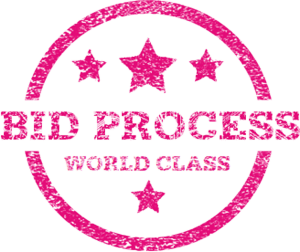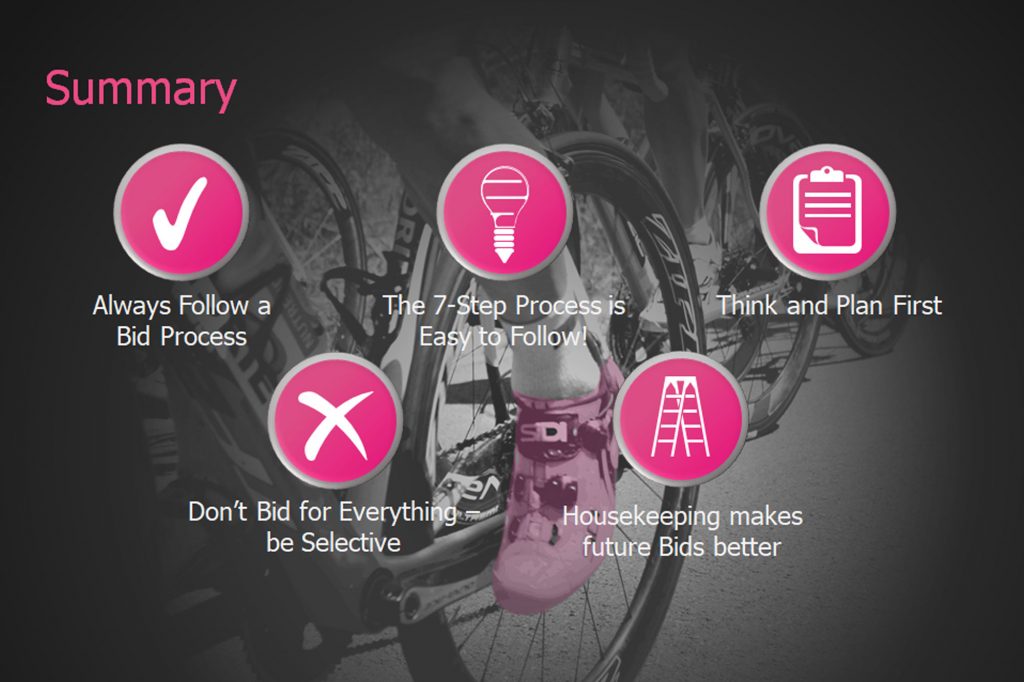 When it comes to winning business on the back of proposals and bids those companies that know exactly how to approach bidding win more business …
When it comes to winning business on the back of proposals and bids those companies that know exactly how to approach bidding win more business …
… those companies are using a defined bid process.
A Simple, Tried and Tested Bid Process
There are many proposal processes out there.
Some of them run to a hundred or more steps! But when you boil the best ones down and simplify them you get something that everyone can use and get value from.
There are just seven basic process steps here.
If you follow these simple steps your proposal win rate should improve and your revenue streams grow commensurately.
1. The Bid / No Bid Decision
 Don’t just bid for a much as you can physically and mentally handle!
Don’t just bid for a much as you can physically and mentally handle!
Decide when to deploy your precious organisation and when to conserve them for opportunities that you can win.
The best way to do this is create a Bid / No Bid decision mechanism and run all opportunities through it to assess their fit with your strategic business objectives.
2. Plan
Before doing anything else draft your bid plan and jot down your initial ideas.
How can this bid best be resourced, who needs to be on the team, and how can we show that we are the best supplier, the one that must be selected, in this proposal?
3. Hold a Kick-Off Meeting and Nail your Win Themes
Bidding is a team effort demanding multiple skills. Get the core team together in a Kick-Off meeting to brainstorm ideas.
Keep the best ideas and throw away the rest.
Once each person on the team has discussed the opportunity and had their say everyone shares the mission to win this bid and takes “ownership” of the tasks they have agreed to.
4. Secure Everyone’s Buy-In
Not everyone who is contributing to your important proposal will be / should be at your Kick-Off meeting.
Your earlier Kick-Off meeting will have finalised the Bid Plan, individual responsibilities and a timeline for submissions by individual named experts.
Now reach out to all your subject matter experts and brief them. Get them on your side and on to the wider team!
5. Write It
You are 5 out of 7 steps in. Only now is it time for you and your contributors to start writing!
Hone your mission-critical Executive Summary and ensure everyone knows your Win Themes.
By so doing every piece of your emerging jigsaw consistently echoes and re-states your key differentiators.
It’s the things that prove to buyers that you are different that win bids.
6. Red Team Meeting and Sign Offs
Armed with a solid candidate version of the proposal call in the “big guns”; your senior managers, directors and signing authorities.
They’ll bring fresh eyes to your bid as well as having the authority to approve critical components of your offer.
For example, the Commercial Director will want to review the Financial Section. Beware! A director may, quite legitimately, not be happy to sign something off.
The Red Team review meeting is the moment to understand exactly why approval is being withheld so that you can make the necessary changes to get sign off later.
7. Compile and Submit
Take all of the feedback received and develop a final set of actions to push towards the final release with the appropriate permissions from company leaders.
Publish the bid and submit it in the required form (hardcopy, softcopy or via an electronic portal).
Now What?
Rest? Party? Start on the next bid?!
The dust settles pretty quickly on a submitted proposal. Yet it may be weeks or even months before you know whether you have won it or been shortlisted, so there’s not much you can now meaningfully do on this particular bid.
Maybe other bid opportunities are flowing your way: you might be straight into another proposal cycle?
This is where your Bid / No Bid gateway can help.
If people have put 100% into trying to win a really good piece of business, should you really be asking them to do the same again for just a mediocre piece of business, or something that you have merely a remote chance of?
Instead, try to build moments of housekeeping into your process to get ready for what is inevitably going to come at you in the future.
 For example, you may have created some really slick graphics for the last bid.
For example, you may have created some really slick graphics for the last bid.
Make sure these are added to your bid library so that they can easily be found and deployed for future bids.
In the white heat of bidding there is nothing more frustrating than not being able to find a diagram or a great section of text that you know exists but you cannot find!
And if you’ve not got a Bid Library of your most commonly used and best proposal assets then build one.
An optimal Proposal Process has to allow for some downtime and housekeeping, if not simply to avoid your best guys burning out.
Summary
A simple bid process can add value even when there’s only one or two of you in the Bid Team.
Undertaking these seven steps brings a laser-like focus to bidding activities.
Where large real and virtual teams are building complex, very high value proposals being able to link back multiple tasks to a simple, overarching “spine” process keeps you grounded and maintains that essential “big picture” perspective.
- Follow a bid process: companies that do enjoy greater proposal success
- The 7-step simple process is a great start point – easy yet highly practical
- Think and plan before you do anything
- Don’t bid for everything: select your bids carefully and conserve your company resources
- Build in time for housekeeping so that you are better prepared for the next bid
Here at The Winning Proposal we help companies build and refine bid processes as well as providing tools necessary to make the bid process really sing and dance, such as the Bid / No Bid decision making matrix. Please let us know if you think we might be able to help.



